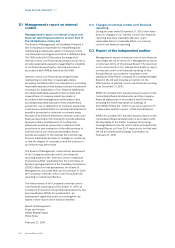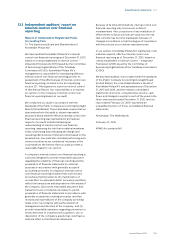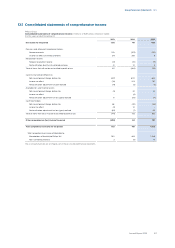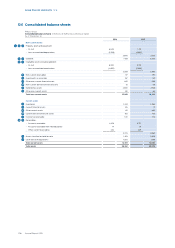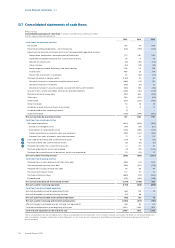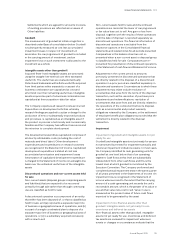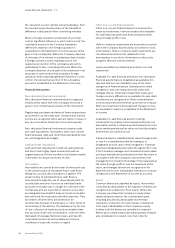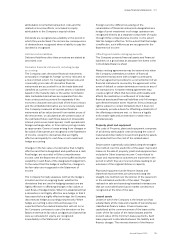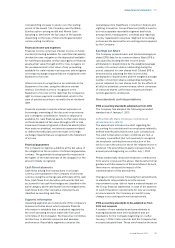Philips 2015 Annual Report Download - page 112
Download and view the complete annual report
Please find page 112 of the 2015 Philips annual report below. You can navigate through the pages in the report by either clicking on the pages listed below, or by using the keyword search tool below to find specific information within the annual report.
Group nancial statements 12.9 1
112 Annual Report 2015
12.9 Notes
Notes to the Consolidated nancial statements of
the Philips Group
1Signicant accounting policies
The Consolidated nancial statements in the Group
nancial statements section have been prepared in
accordance with International Financial Reporting
Standards (IFRS) as endorsed by the European Union
(EU) and with the statutory provisions of Part 9, Book 2
of the Dutch Civil Code. All standards and
interpretations issued by the International Accounting
Standards Board (IASB) and the IFRS Interpretations
Committee eective year-end 2015 have been
endorsed by the EU, except that the EU did not adopt
some of the paragraphs of IAS 39 applicable to certain
hedge transactions. Koninklijke Philips N.V. (hereafter:
the ‘Company’ or ‘Philips’) has no hedge transactions to
which these paragraphs are applicable. Consequently,
the accounting policies applied by Philips also comply
with IFRS as issued by the IASB. These accounting
policies have been applied by group entities.
The Consolidated nancial statements have been
prepared under the historical cost convention, unless
otherwise indicated. The Consolidated nancial
statements are presented in euro, which is the
presentation currency.
On February 23, 2016, the Board of Management
authorized the Consolidated nancial statements for
issue. The Consolidated nancial statements as
presented in this report are subject to adoption by the
Annual General Meeting of Shareholders, to be held on
May 12, 2016.
Use of estimates
The preparation of the Consolidated nancial
statements in conformity with IFRS requires
management to make judgments, estimates and
assumptions that aect the application of accounting
policies and the reported amounts of assets, liabilities,
income and expenses. These estimates inherently
contain a degree of uncertainty. Actual results may
dier from these estimates under dierent assumptions
or conditions.
These estimates and assumptions aect the reported
amounts of assets and liabilities, the disclosure of
contingent liabilities at the date of the Consolidated
nancial statements, and the reported amounts of
revenues and expenses during the reporting period.
The Company evaluates these estimates and
judgments on an ongoing basis and base our estimates
on historical experience, current and expected future
outcomes, third-party evaluations and various other
assumptions that we believe are reasonable under the
circumstances. The results of these estimates form the
basis for making judgments about the carrying values
of assets and liabilities as well as identifying and
assessing the accounting treatment with respect to
commitments and contingencies. The Company revises
material estimates if changes occur in the
circumstances or there is new information or
experience on which an estimate was or can be based.
The areas where the most signicant judgments and
estimates are made are goodwill, deferred tax asset
recoverability, impairments, nancial instruments, the
accounting for an arrangement containing a lease,
revenue recognition (multiple element arrangements),
assets and liabilities from employee benet plans, other
provisions, uncertain tax positions and other
contingencies, classication of assets and liabilities
held for sale and the presentation of items of prot and
loss and cash ows as continued or discontinued, as
well as when determining the fair values of acquired
identiable intangible assets based on an assessment
of future cash ows.
Further judgment is applied when analyzing
impairments of goodwill and intangible assets not yet
ready for use that are performed annually and
whenever a triggering event has occurred to determine
whether the carrying value exceeds the recoverable
amount. These analyses generally are based on
estimates of future cash ows. Furthermore, the
Company applies judgment when actuarial
assumptions are established to anticipate future events
and are used in calculating post-employment benet
expenses and liabilities. These factors include
assumptions with respect to interest rates, rates of
increase in healthcare costs, rates of future
compensation increases, turnover rates and life
expectancy.
Changes in accounting policies
The accounting policies set out in this section have
been applied consistently for all periods presented in
these Consolidated nancial statements.
Prior-year information
The presentation of certain prior-year disclosures have
been adjusted to align with the current year disclosures.
Specic choices within IFRS
Sometimes IFRS allows alternative accounting
treatments for measurement and/or disclosure. The
most important of these alternative treatments are
mentioned below.
Tangible and intangible xed assets
Under IFRS, an entity shall choose either the cost model
or the revaluation model as its accounting for tangible
and intangible xed assets. In this respect, items of
property, plant and equipment are measured at cost
less accumulated depreciation and accumulated
impairment losses. The useful lives and residual values
are evaluated annually. Furthermore, the Company
chose to apply the cost model meaning that costs
relating to product development, the development and




